Vineyard trellis is key to success
18th November 2022
The trellis system is one of the key factors influencing the success of a vineyard, after the suitability of the site, and selection of appropriate varieties, clones, and rootstocks. With trellis costs representing around 50% of the budget, Alistair Nesbitt from Vinescapes Ltd explains how to get it right
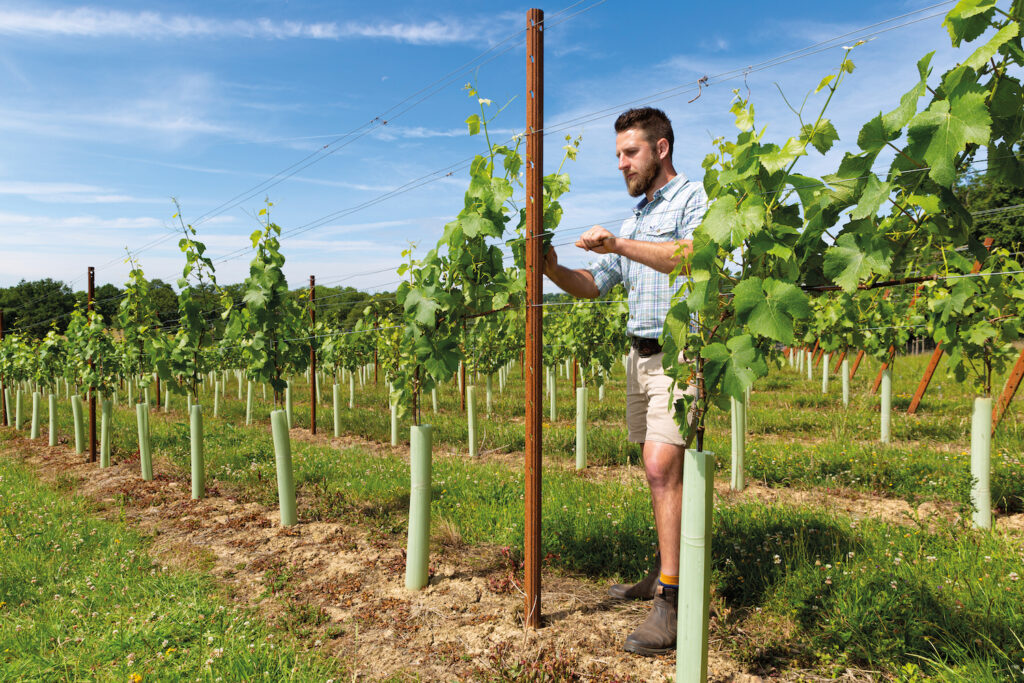
VSP system showing fruiting wire and three sets of canopy wires
There are close to 4,000ha of vineyards in the UK, and the industry is growing rapidly with around 1.5 million vines being planted in the UK each year. These all need trellis to support them – and that’s a lot of posts, anchors, and many miles of wire.
The trellis needs to last the lifetime of the vineyard and adapt to future changes the industry may face, such as the need for increased mechanisation. So, it is important for it to be designed and constructed by an experienced and professional team using the best quality materials, technology, and techniques.
Why use trellis?
In its natural habit, a vine is a climbing plant that grows up trees or other structures to reach sunlight and ripen its grapes, which then attract birds for seed dispersal. Vines are more productive in sunny rather than shady conditions, as photosynthesis is needed to produce the energy for the development of quality fruit. Also, formation of the buds for the following year’s crop is dependent on sunshine and warmth on the developing renewal canes.
The aim of the trellis is to support the vine and place the shoots in the optimal position to achieve the best yields and quality, by maximising leaf area for light interception and allowing air movement to reduce disease. The trellis keeps the vine off the ground for undervine management of weeds and the vineyard floor area. The trellis also allows for manipulation of the canopy shape for efficient spray penetration and other operations – both manual and mechanical. Therefore, the trellis has a significant influence on the productivity and profitability of the vineyard.
What are the trellis choices?
There are many different trellis system options. The type of trellising depends on site-specific factors which influence vine vigour – such as climate, soil type, drainage, topography and frost risk – as well as variety and rootstock, and the requirement of mechanised vineyard tasks. An understanding of these factors is needed to design the correct vineyard and trellis systems for the vineyard’s success.
The online land evaluation tool, VineMAP, developed by Vinescapes, along with the company’s professional site assessment, can provide these facts and figures to guide business success.
There are many trellis systems used across wine regions worldwide, adapted to specific growing conditions. However, in the UK, the Vertical Shoot Positioning system (VSP) is the most common, but other systems found occasionally include Geneva Double Curtain (GDC), Sylvos, Lyre and Scott Henry. In the early years of vine growing in England and Wales, GDC was relatively common as its divided canopy can allow higher vigour vines to achieve good yields.
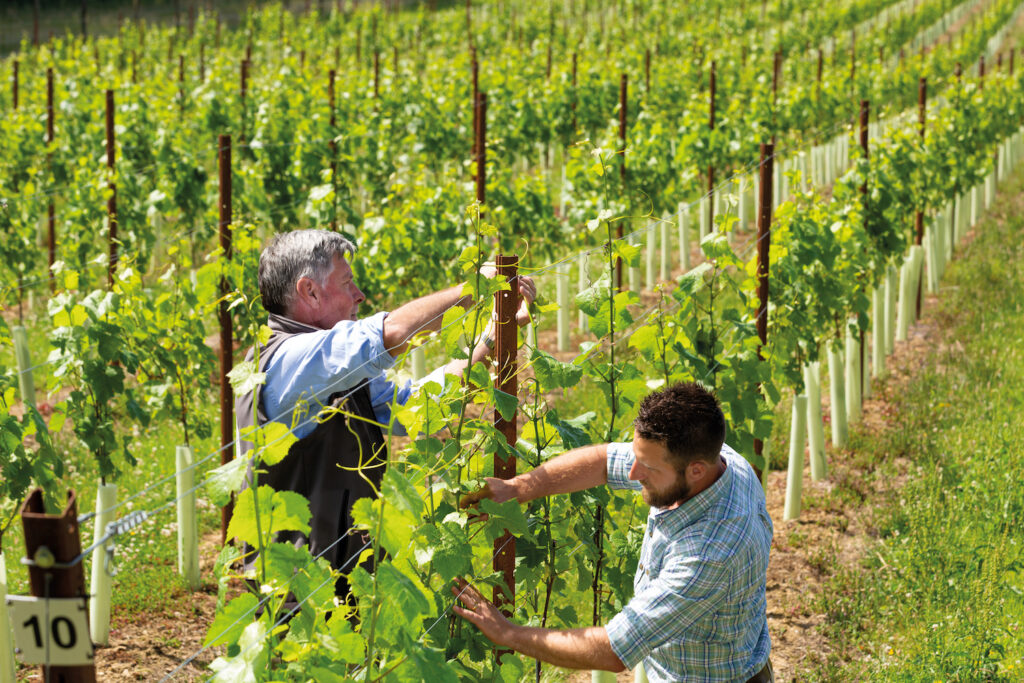
Tucking in: Using the canopy wires to position the shoots upright
Vertical Shoot Positioning system (VSP)
The VSP system has a fixed fruiting wire relatively close to the ground, at around 80–90cm, and at pruning the dormant cane or canes are attached to this – a system known as Guyot. The shoots are then trained upwards during the growing season, with the grape clusters found on the shoots, above the fruiting wire. In the UK vines are mostly cane pruned, where the canes are replaced each season. An alternative method is spur pruning on a permanent cordon, but this is generally more suited to climates warmer than most found in the UK. Moveable canopy wires then support the shoots in an upright position as the canopy grows. Canopy management tasks are important during the growing season to position shoots, trim or hedge, and for leaf removal – to optimise quality and yields. The VSP system, if installed correctly allows for mechanisation of many canopy tasks, including trimming and leaf removal, and if the wine style allows, harvest. Keeping the canopy open allows air movement and reduces humidity, which fungal diseases favour. The open canopy also improves the efficacy of spray applications. Mechanisation of pruning is easier with spur pruned vines, but mechanised pre-pruning is becoming increasingly common with cane pruned VSP systems, due to cost savings.
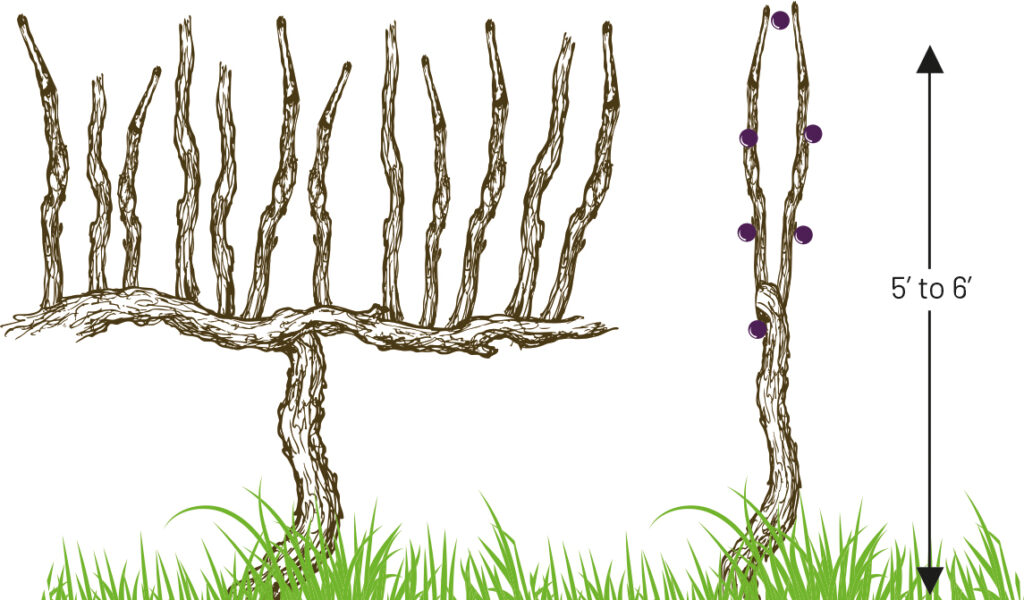
VSP trellis canopy wire
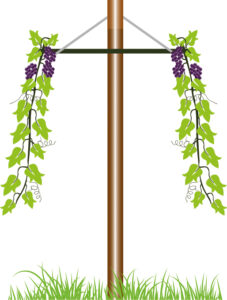
Geneva Double Curtain system
Geneva Double Curtain (GDC), Scott Henry and Lyre
The GDC trellis system is a horizontally divided canopy system and improves light penetration to the canopy interior. It is more suited to high vigour sites, whereas VSP is generally used for lower or medium vigour. Therefore, it’s important to anticipate likely vigour before planting the vineyard to select the right varieties, rootstocks, and trellis system. Vine vigour potential is influenced by the site’s climate, soil type, available rooting depth, moisture, and nutrient availability as well as management practices. In the right site, properly managed, GDC can result increased productivity.
GDC is separated into two ‘curtains’ of canopy. There are two support wires that are separated by cross arms and the cordons are trained on these. GDC and other divided canopies tend to be more expensive to install and manage, but often justify their costs in higher yields. Scott Henry and Lyre are also divided canopy systems that are used occasionally in the UK, particularly with high vigour.
Posts, anchors, and wires
The trellis supports the weight of the vine canopy and fruit, and it must be structurally sound to cope with wind, rain, and vineyard mechanisation for the lifetime of the vineyard. Along the row, the intermediate posts, and the high tensile wires transfer much of this weight to the end posts, strainer and ground anchors. The end posts need to be more robust and be driven deeper into the ground. It’s a technical task that requires expert knowledge and experience to ensure correct set up. Getting it wrong results in trellis failure, which is devastating for the vines, as well as expensive and challenging to repair.
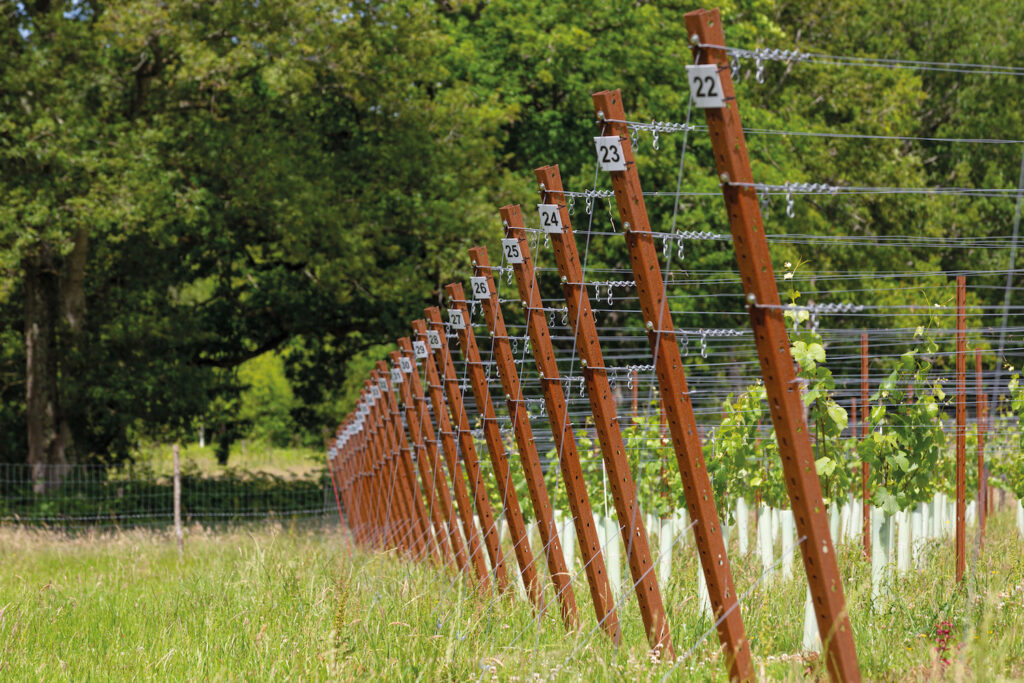
CorTen trellis posts
Trellis posts need to be aesthetically pleasing as during the dormant season they are more obvious and therefore have an impact the landscape for visitors and neighbours. Wood has been used in the past, and considered more attractive than the glare of steel, but even treated wood can rot and deteriorate, especially in wetter soils. There are now naturally ‘weathered’ steel trellis posts available, such as CorTen, that offer the longevity of steel – but their ‘rust’ colouring blends with the winter countryside.
The trellis anchors are where the weight is transferred to the ground via end post tension wires, so have a critical role in avoiding trellis failure. There are several different styles of anchor available, designed to work in different soil types.
The trellis wires support the weight of the vine and fruit and transfer this load, mainly to the end posts and anchors. The fruiting wire needs to be tensioned to the right degree so that it doesn’t sag and should not stretch and resist corrosion. The canopy wires need to be able to support the shoots. If trellis wires break under a heavy crop during the growing season, they are hard to repair and can result in crop losses.
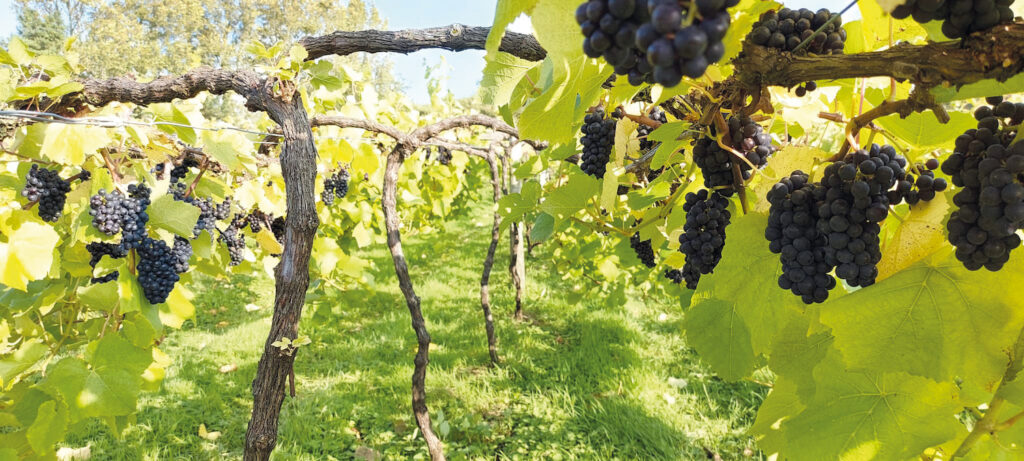
Geneva Double Curtain trained vines
Repairs
The trellis is under a lot of strain during the growing season, so after harvest, as the vine enters the dormant season and loses its canopy, is a good time to check and repair the trellis. If the trellis is not well maintained, it can affect vineyard performance, and lead to higher labour costs. It’s important to check that posts are stable, the fruiting wires are tight and canopy wires moveable but not too loose. Gripple, a small wire joining and re-tensioning device, makes wire maintenance much easier – especially for fixing wires cut accidentally when using electric pruning secateurs.
ABOUT OUR AUTHOR
Alistair Nesbitt holds a PhD in viticulture and climate science and a BSc and Masters degree in Viticulture & Oenology. He is CEO of Vinescapes Ltd, which offers a comprehensive ‘Ground to Grape to Glass’ service including bespoke vineyard creation, vineyard management, consultancy, mentoring and training to help UK wine production businesses establish and operate sustainably.
